


Navigating your recovery journey after Genicular Artery Embolization (GAE) can feel overwhelming, but you’re not alone. Here are ten key steps designed to help you through this process, emphasizing the importance of personalized care and support.
Personalized care is essential. Each recovery journey is unique, and understanding your specific needs can make a significant difference. Have you considered how your individual circumstances might shape your recovery?
Gradual movement is crucial. Start with gentle activities that feel comfortable for you. This approach not only aids in physical recovery but also boosts your confidence. Remember, every small step counts!
Physical therapy can be a valuable resource. Engaging with a therapist can provide you with tailored exercises that promote healing and strength. Have you thought about reaching out to a professional for guidance?
Emotional well-being is just as important as physical health. It’s normal to experience a range of emotions during recovery. Surrounding yourself with supportive friends and family can help you navigate these feelings.
Community support plays a vital role too. Connecting with others who have undergone similar experiences can provide comfort and encouragement. Consider joining a support group or online community where you can share your journey.
Celebrate small victories along the way. Each achievement, no matter how minor it may seem, is a step towards your overall recovery. How will you acknowledge your progress?
By focusing on these steps—personalized care, gradual movement, physical therapy, emotional well-being, community support, and celebrating victories—you can enhance your recovery outcomes and improve your quality of life. Remember, you are valued, and support is always available to help you through this journey.
Navigating the recovery journey after Genicular Artery Embolization (GAE) can feel overwhelming, yet it also holds the promise of transformation. For patients, grasping the essential steps that lead to successful healing is crucial. This article explores ten vital strategies aimed at enhancing recovery outcomes, highlighting the significance of personalized care and community support.
Reflecting on these questions can pave the way for a smoother, more fulfilling recovery experience. Remember, you’re not alone on this journey; support is available every step of the way.
At Amavita Heart and Vascular Health, we truly care about delivering exceptional cardiovascular care, especially for those involved in the GAE patient story recovery from Genicular Artery Embolization (GAE). We understand that each GAE patient story recovery is unique, and we’re committed to tailoring our approach to meet your individual needs. This personalized care is vital for improving recovery outcomes in the GAE patient story recovery, particularly for older adults who may face specific challenges during their recuperation.
We integrate advanced techniques like:
with innovative research and clinical trials. Our goal is to enhance your quality of life and support you every step of the way. In addition to this, our involvement in community outreach initiatives, such as the Miami Initiative to Stop Amputation, highlights our dedication to providing culturally sensitive care and addressing preventable health issues.
This holistic approach ensures that your experience is collaborative and supportive, reflecting our mission to transform cardiovascular care. We’re here for you, ready to help you navigate your recovery through the GAE patient story recovery with compassion and understanding. If you have any concerns or questions, please don’t hesitate to reach out. Your health and well-being are our top priorities.
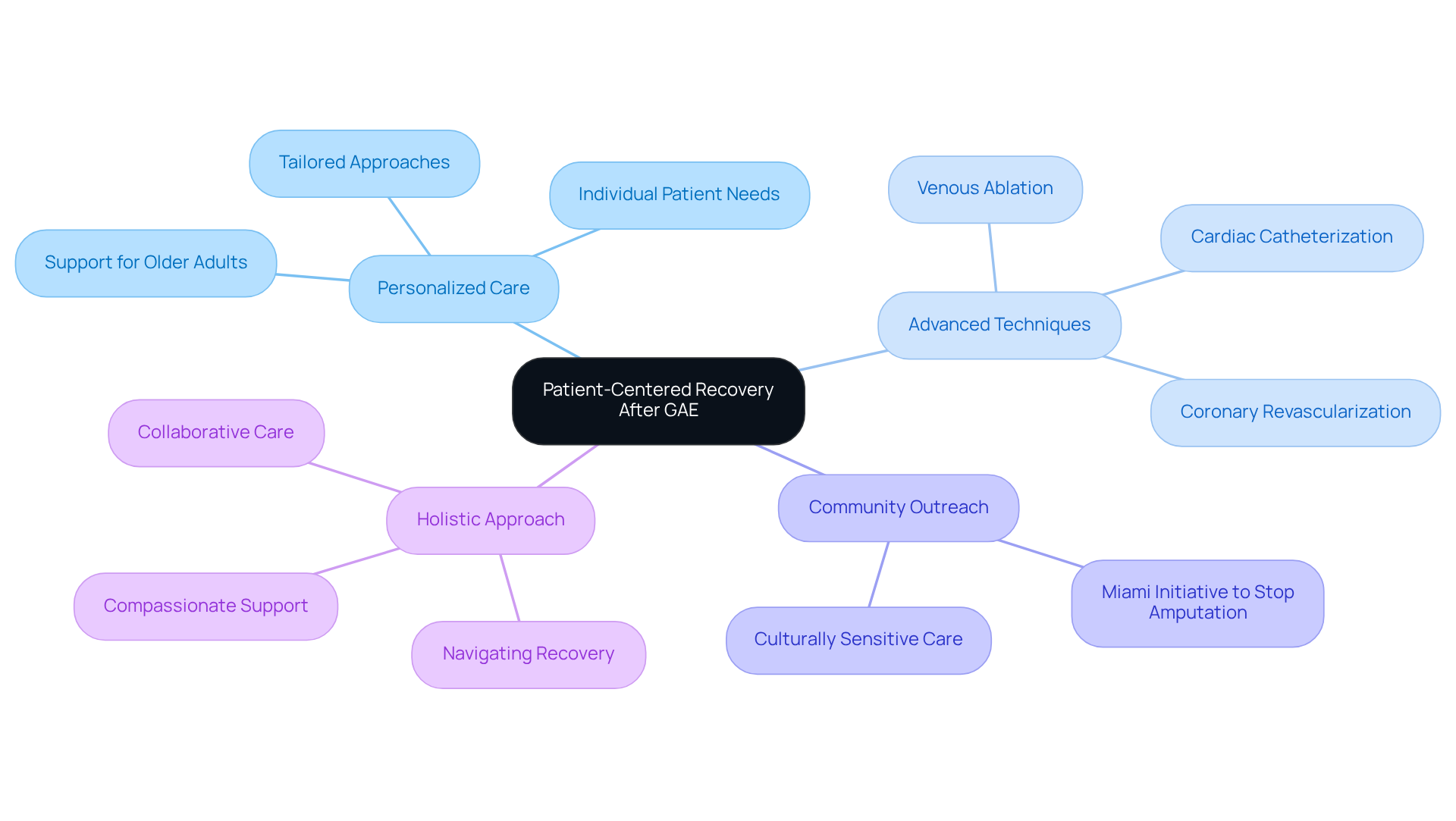
After undergoing Genicular Artery Embolization (GAE), it’s essential to prioritize rest during the first 24 to 48 hours. This initial period is crucial for allowing your body to heal without unnecessary strain. You might be wondering how soon you can get moving again. Typically, patients can start walking within two to three hours after the procedure. Gradually incorporating light movements, like short walks or gentle stretching, can be very beneficial. Not only does this help reduce stiffness, but it also improves circulation, which is vital for your healing process.
Physical therapists emphasize the importance of listening to your body and adjusting your activity levels accordingly. This approach is key to achieving the best rehabilitation results. Many successful healing stories, such as the GAE patient story recovery, show that individuals who balance rest with gradual movement often experience enhanced mobility and less discomfort. For instance, numerous patients share their experiences in the GAE patient story recovery, reporting significant relief from osteoarthritis knee pain within just two weeks after the procedure. This highlights how important it is to follow this supportive approach during your post-surgical healing phase.
Remember, you’re not alone in this journey. If you have any concerns or questions, don’t hesitate to reach out for support. Your well-being is our priority, and we’re here to help you every step of the way.
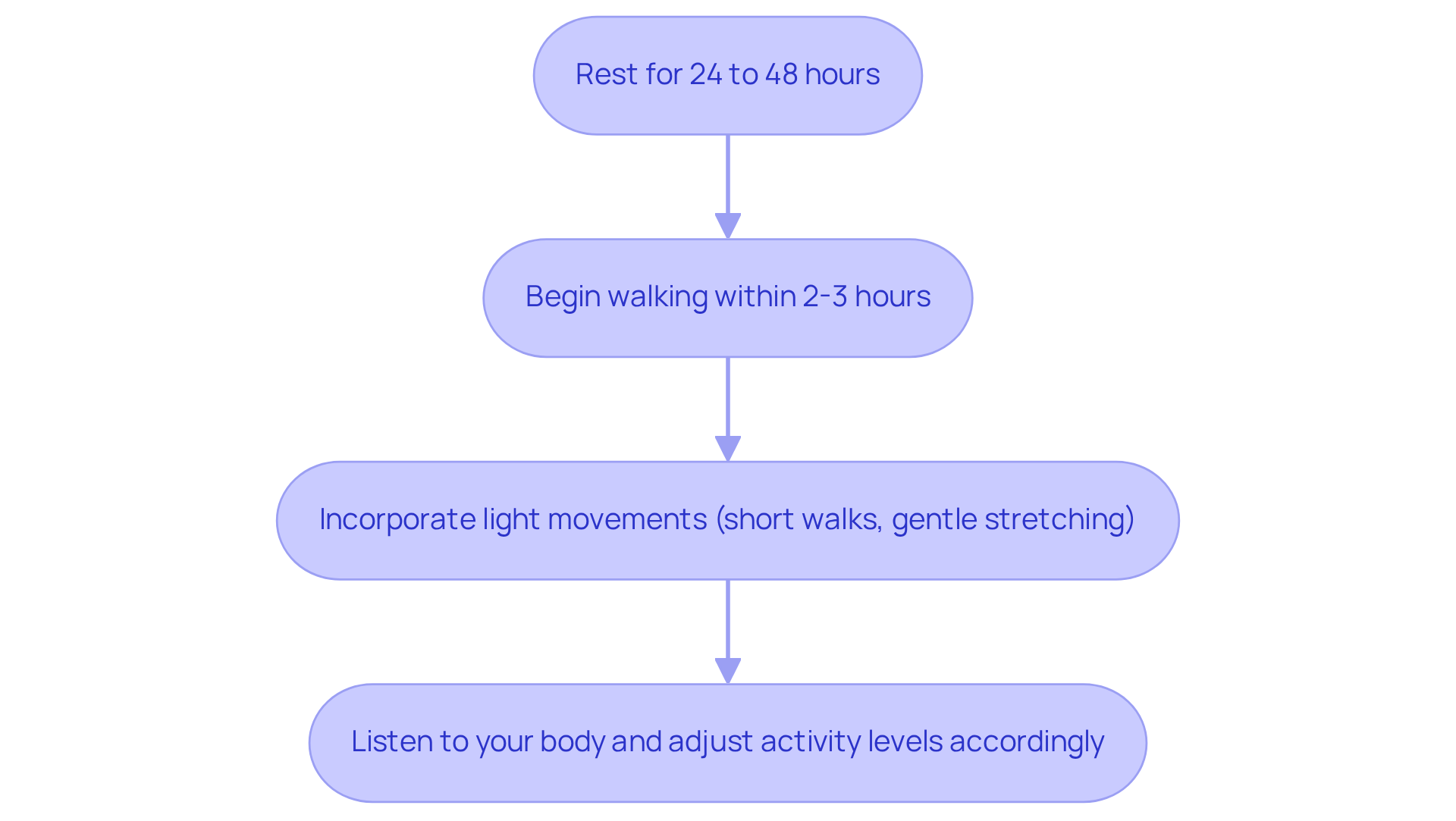
Participating in physical rehabilitation after Genicular Artery Embolization (GAE) is essential for enhancing your recovery. Have you ever wondered how a tailored rehabilitation program could make a difference? It focuses on gentle exercises designed to improve your strength, flexibility, and range of motion. With the guidance of compassionate therapists, you’ll engage in specific movements that are safe and effective, helping to rebuild muscle strength around your knee joint.
In addition to this, methods like cryotherapy and compression can be included to reduce swelling and support your healing journey. Regular counseling meetings not only provide encouragement and accountability but also ensure you remain committed to your recovery goals. Recent studies show that personalized rehabilitation strategies can significantly improve functional outcomes, with many individuals experiencing a 30% to 50% reduction in pain levels within months after the procedure.
As Dr. Alexander Lam wisely noted, "Physical rehabilitation after GAE provides a comprehensive approach to recovery." Success stories, such as the GAE patient story recovery, from individuals like you highlight the profound impact these programs can have, showcasing how structured physical therapy leads to remarkable improvements in mobility and overall quality of life. This holistic approach not only helps alleviate pain but also empowers you to regain your independence and return to daily activities more swiftly. Remember, you’re not alone on this journey; support is available every step of the way.
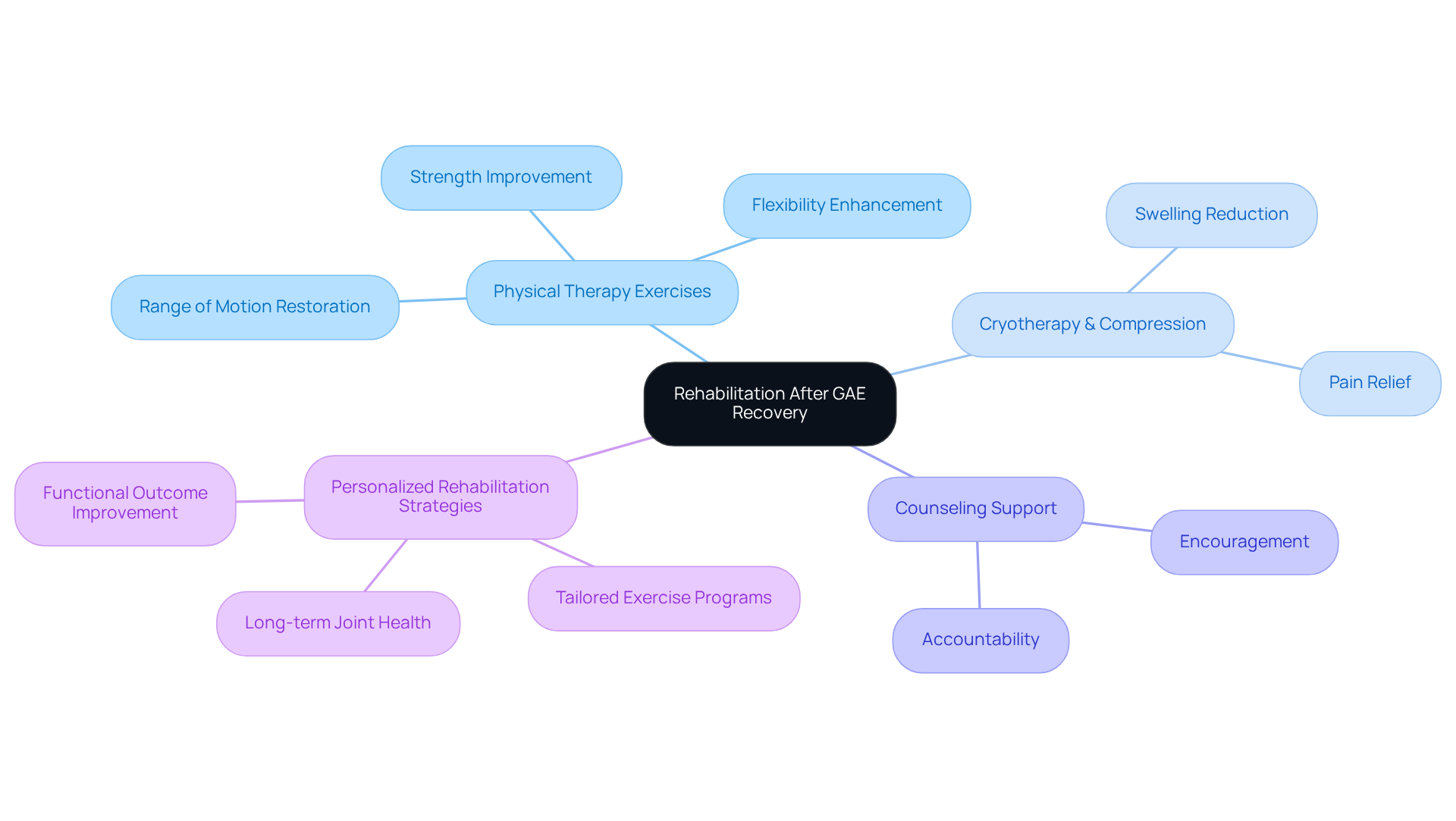
As you navigate the healing phase after GAE, it’s essential to stay vigilant for any potential complications during your GAE patient story recovery. You might wonder, what should I be looking out for? Signs like excessive bleeding, persistent pain, or fever are important to monitor. Regular follow-up appointments with your healthcare providers can be a comforting way to identify and address any issues early on.
In addition to this, maintaining open communication with your care team is crucial. By sharing your concerns and experiences, you can ensure a safer healing journey. Remember, you’re not alone in this process; your healthcare team is here to support you every step of the way.
So, if you notice anything unusual or have questions, don’t hesitate to reach out. Your health and peace of mind are what matter most, and together, we can work towards a smooth GAE patient story recovery.

Engaging with community support can truly be a powerful ally in your healing journey from GAE. Have you considered sharing your experiences with family, friends, or support groups? This sharing not only offers emotional comfort but also opens the door to learning from one another's journeys.
Connecting with individuals who have faced similar procedures can provide valuable insights and encouragement, making the healing process feel less daunting. Remember, you’re not alone in this; there are others who understand what you’re going through.
In addition to this, reaching out for support can foster a sense of belonging and reassurance. It’s perfectly normal to feel hesitant or anxious about your health, but taking that first step towards sharing can lead to meaningful connections and support.
So, why not take a moment to reflect on who you might reach out to? Whether it’s a loved one or a support group, sharing your story can be a significant step towards healing. You deserve to feel supported and understood as you navigate this journey.
Establishing realistic healing objectives is essential for your healing journey after GAE. Have you thought about what goals you’d like to set? Working closely with your healthcare team can help you create specific, measurable, achievable, relevant, and time-bound (SMART) goals. These can range from simple tasks, like walking a certain distance, to more complex objectives, such as returning to your daily activities.
Celebrating even the smallest achievements along the way can significantly boost your motivation and foster a positive mindset throughout your healing process. Remember, every step forward is a victory worth acknowledging.
In addition to this, don’t hesitate to share your feelings and concerns with your healthcare team. They are there to support you and can help tailor your goals to fit your unique needs. You’re not alone in this journey; together, you can navigate the path to recovery, as highlighted in the GAE patient story recovery.

Staying informed about the GAE patient story recovery process after Genicular Artery Embolization (GAE) is essential for achieving the best possible outcomes. Have you ever wondered how understanding your healing journey can make a difference? Patients are encouraged to seek information from trustworthy sources, like healthcare providers and educational materials. Understanding the typical healing timeline, potential complications, and effective self-care strategies is essential for you to take charge of your GAE patient story recovery. This proactive approach not only boosts your confidence but also helps you stick to rehabilitation protocols.
Research shows that individuals who are well-informed tend to heal faster and report higher satisfaction levels. In fact, studies indicate a 33% increase in satisfaction and a 19% decrease in post-surgical complications among those who felt adequately educated before their procedures. It’s concerning to note that a Gallup study found only 37% of respondents felt they received enough information about their upcoming procedures. This highlights the importance of seeking reliable information.
GAE is a minimally invasive outpatient procedure, offering several advantages over more invasive options like knee replacement surgery. By actively participating in your GAE patient story recovery, you can significantly improve your overall health outcomes. Remember, education can also help address any psychosocial barriers you may face. You’re not alone in this; reaching out for support can make all the difference.
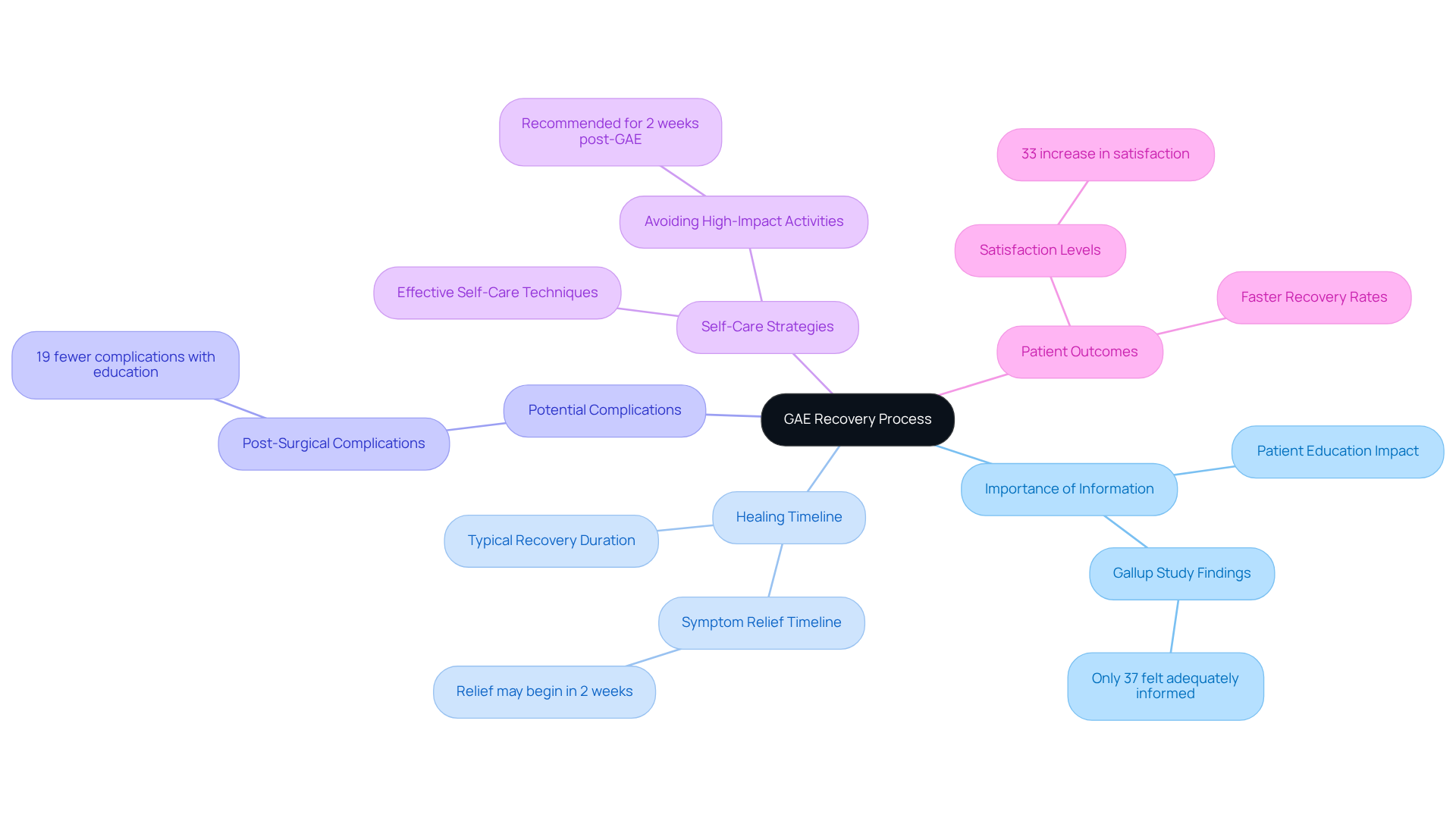
Prioritizing emotional well-being is crucial as part of the GAE patient story recovery process. Have you considered engaging in activities that promote relaxation and reduce stress? Mindfulness, meditation, and gentle yoga can be wonderful ways to nurture your spirit during this time.
In addition to these practices, seeking support from mental health professionals or joining support groups can offer valuable coping strategies. Connecting with others who understand your journey can make a significant difference. Recognizing and addressing emotional challenges not only enhances your healing process but also improves your overall quality of life.
Remember, you’re not alone in this. It’s perfectly okay to reach out for help and explore these supportive avenues. Your emotional health matters, and taking these steps can lead to a more fulfilling recovery.

Recognizing and celebrating small achievements during the GAE patient story recovery can truly uplift motivation. Have you noticed your progress, like taking an extra step each day or managing pain more effectively? These little victories are powerful reminders of your healing path, reinforcing your commitment to personal goals. Research shows that acknowledging even minor accomplishments can spark positive momentum, enhancing emotional well-being and building resilience.
Celebrating these small wins fosters a sense of safety and control in therapy, which is crucial for effective healing. Sharing your achievements with supportive friends, family, or support groups can amplify those feelings of accomplishment and strengthen the community support that’s vital for ongoing recovery. Many successful stories illustrate how these small milestones—such as keeping a daily win journal to track your accomplishments—can contribute to GAE patient story recovery by fostering a brighter outlook and greater engagement in rehabilitation efforts.
By focusing on these incremental successes, you can nurture a sense of safety and control, ultimately paving the way for improved recovery outcomes. Remember, every step forward counts, and you’re not alone on this journey.
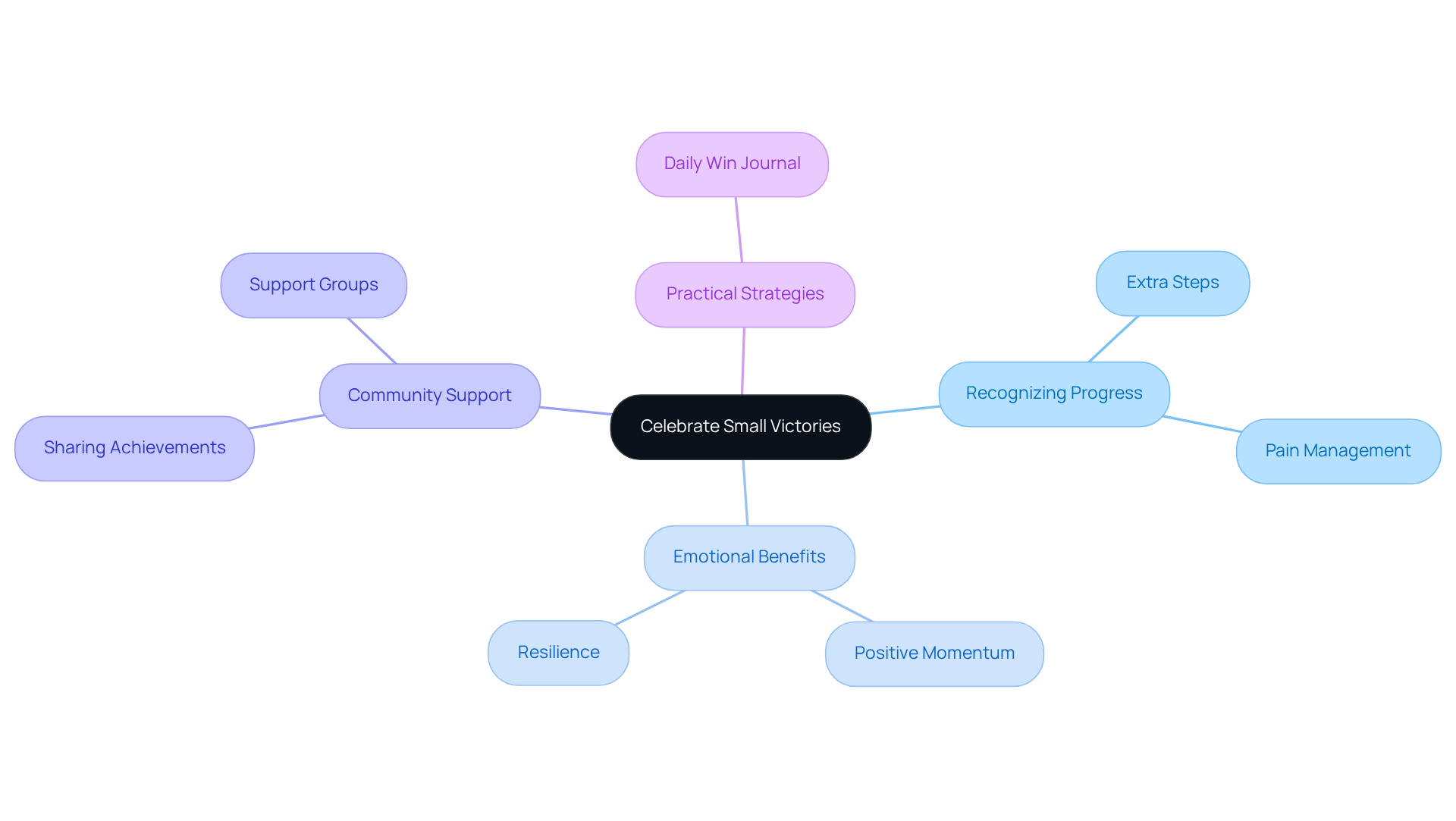
Every aspect of the GAE patient story recovery journey highlights the importance of a personalized, patient-centered approach. By understanding the unique needs and challenges faced by individuals recovering from Genicular Artery Embolization, we can significantly enhance recovery outcomes. This journey isn’t just about physical healing; it also encompasses emotional well-being, community support, and informed decision-making, all of which play crucial roles in achieving a successful recovery.
Have you considered how rest and gradual movement can aid your healing? Engaging in physical therapy and monitoring potential complications are vital steps in this process. Setting realistic recovery goals and celebrating small victories can foster motivation and resilience throughout your healing journey. Remember, community engagement and emotional support enrich your experience, ensuring you don’t feel isolated during this time.
Ultimately, embracing these ten key steps can lead to a more fulfilling and effective recovery from GAE:
By prioritizing both your physical and emotional health, you can navigate your healing journey with confidence and support. It’s essential to remain proactive, seek information, and engage with healthcare providers and support networks. These elements are vital for achieving optimal recovery outcomes. Every step you take towards understanding and improving your health is a step towards a brighter future.
What is the focus of Amavita Heart and Vascular Health regarding GAE recovery?
Amavita Heart and Vascular Health prioritizes patient-centered recovery for individuals involved in the GAE patient story recovery from Genicular Artery Embolization (GAE), offering personalized care to improve recovery outcomes.
What advanced techniques are integrated into the care for GAE patients?
The care for GAE patients includes advanced techniques such as cardiac catheterization, coronary revascularization, and venous ablation, along with innovative research and clinical trials.
How does Amavita support community health initiatives?
Amavita is involved in community outreach initiatives, such as the Miami Initiative to Stop Amputation, which reflects their commitment to providing culturally sensitive care and addressing preventable health issues.
What should patients prioritize during the first 24 to 48 hours after GAE?
Patients should prioritize rest during the first 24 to 48 hours after GAE to allow their bodies to heal without unnecessary strain.
When can patients typically start moving after the GAE procedure?
Patients can typically start walking within two to three hours after the GAE procedure, gradually incorporating light movements like short walks or gentle stretching.
Why is it important to listen to your body during recovery from GAE?
Listening to your body and adjusting activity levels accordingly is crucial for achieving the best rehabilitation results and enhancing mobility while minimizing discomfort.
What role does physical therapy play in GAE recovery?
Physical therapy plays a vital role in GAE recovery by providing tailored rehabilitation programs that focus on gentle exercises to improve strength, flexibility, and range of motion around the knee joint.
What additional methods can support the healing process after GAE?
Methods such as cryotherapy and compression can be included in the recovery process to reduce swelling and support healing.
What improvements can patients expect from personalized rehabilitation strategies?
Personalized rehabilitation strategies can lead to a significant improvement in functional outcomes, with many individuals experiencing a 30% to 50% reduction in pain levels within months after the procedure.
How does Amavita ensure support for patients during their recovery journey?
Amavita provides support through regular counseling meetings, compassionate therapists, and a commitment to helping patients achieve their recovery goals, ensuring they are not alone on their journey.